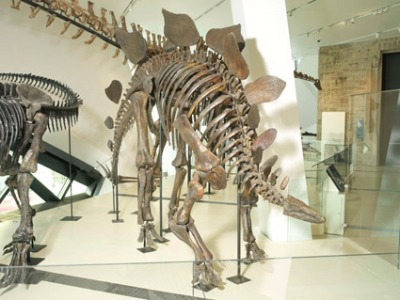Theater buff finds Toronto's other highlights delightful

The dinosur exhibit is just one of the many treasures visitors to Toronto's Royal Ontario Museum will encounter in the spacious, four-story building.
Photo courtesy of the Royal Ontario Museum
By Shera Cohen
In the Spotlight
The topic of most of my articles – both in PRIME and on my website,
www.inthespotlightinc.org – is theatre. However, I decided to be spontaneous (hmm, is that a contradiction?) during my recent visit to Toronto. No theatre this time, I was just going to visit buildings. These were not row houses aligning expensive and cozy streets (well, there actually were many), box stores (I wasn't looking for Wal-Mart, et al, but I didn't see any) or malls (although one of the biggest in the world was five blocks from the hotel), but libraries, museums, and castles. So, I use the word "buildings" here broadly.
The Hop On & Off bus,with its cartoony map, cost only $31 for a consecutive three-day pass and the opportunity to view up to 24 sites. This was a true bargain. Needless to say, we hit several key spots, drove by others, and missed several. The tour guides, mostly college students, were a fun bunch, often veering off their megaphone-amplified scripts to add anecdotes of their own.
An encompassing museum
The Royal Ontario Museum (ROM), surely the largest museum in one building that I had ever seen, included everything "old" from every continent. A monstrous size dinosaur greeted us in the entry. Of course, Canadian artifacts were paramount; impressing me most were the extremely high, intricately designed totem poles. As part of the Toronto Photography Festival, then taking place, special exhibits were devoted in numerous galleries. Treasures displayed on the four levels included Ming tombs, the bust of Cleopatra, and the Tagish Lake Meteorite; atop the museum was an elegant dining room. Especially intriguing was the Textile Room, with pieces that ranged from ancient Canadian Indian tribes to 1950s Christian Dior. Those who know me can attest that I easily get lost – outdoors and indoors. ROM's map was one of the most helpful for people like me. Allotting only a three-hour tour did not do the museum, or us, justice. For more information, visit
www.rom.on.ca.
Detecting a great library
I hopped off the Hop On & Off Bus when the guide pointed out the Toronto Reference Library, which happened to be near something else that didn't interest me. I'm not sure if he said it was the largest reference library in the world, or one of the largest, but it was big, modern, state-of-the-art, quiet, and lovely with its indoor flowing waterfall and garden. The library's architectural design, mass of computers, cushy upholstered furniture, and caf provided all a book lover would want. While I didn't ask about the stats – number of books, pictures, maps, etc. – the count must have been enormous. The tour guide's story of the Arthur Conan Doyle Room was enough for me to voluntarily hop on over. And, I do use "hop" literally, as I was still recovering from recent foot surgery. Why would a library in Toronto mount an exhibit of Sherlock Holmes? Well, a man who lived in the city just happened to have found dozens of first editions simply by chance. He made a grand donation.
All things footwear
The Bata Shoe Museum is not for shoe lovers only. I can't resist stating that a visit is a "step" into history. From pre-historic days in Africa to turn-of-the--last-millennium Asia to high-style 18th century Europe to Prada sneakers, Bata is a four-story gem right off the main street. A special room was devoted to an all-encompassing sneaker exhibit, which included videos, the progression of sneakers across 150 years, and those worn by the famous and infamous; such as Michael Jordan. The museum's pamphlet questions, "Why shoes" and answers its own question with, "Although feet are the same around the world, what people choose to wear .is incredibly diverse." Bata, which opened in 1979, boasts a world-class collection of more than 13,000 items of footwear and related artifacts. I hadn't Googled Bata prior to my Toronto visit, nor did I expect much from a shoe museum when I walked into the building. It would have been a mistake to remove Bata from my tour. For more information, visit
www.batashoemuseum.ca .
An urban castle
The bus guide called Casa Loma "the castle just around the corner." Indeed, doesn't every city have one of these giant, architecturally unique, spacious, multi-floored, stone-gaited structures in their downtown? The owner was Sir Henry Mill Pellatt (the Thomas Edison of Canada), financier, industrialist, and military man. He made it rich in harnessing electric power from Niagara Falls, and in 1911 spent $3,500,000 to build a medieval castle. A decade later, Pellatt lost his fortune (it's a sad story of business betrayal and red tape) leaving his lavish home to the country of Canada. And, Canada now has the opportunity to show off the grandeur of the three-story structure with its huge library, dainty study of Mrs. Pellatt, round rooms, garden, hidden stairways, stables, and unfinished indoor Olympic-size swimming pool. For more information, visit
www.casaloma.org .
Toronto, definitely a cosmopolitan city with a capital "C," has many firsts. The list was recited throughout each Hop On/Off ride. I forgot most of the names, except there was the man who decided to provide tiny bars of soap and little bottles of shampoo in hotel rooms. What a helpful guy he was.
Shera Cohen is president of In The Spotlight, a Springfield, Mass., nonprofit website, www.inthespotlightinc.org, dedicated to promoting the arts in the Pioneer Valley.

